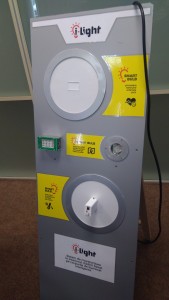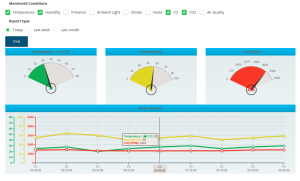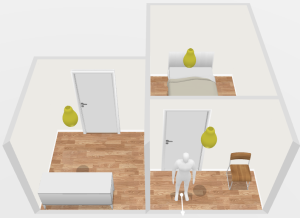WP1 – User requirements, needs, and service concepts
The objective of this work package was to select a user requirements collection and analysis methodology, collect and analyze user requirements regarding the i-Light project context and define a high level model of the technological platform. WP1 spanned over the period M01 – M09 during project implementation and was coordinated by IW, with support from the other two partners. The main outputs of this WP are:
-
A document describing the results of a multi-national survey, including a set of end-user requirements for the system determined following the results’ analysis.
-
A document presenting the user roles and characteristics, use cases, functional and non-functional requirements for the system, all these representing a first phase in guiding the development of the i-Light system.
-
A document that provides the high level model of the technological platform, which briefly describes the main hardware and software components and their basic functionalities and proposes technological choices for the implementation.
WP2 – System design, development and integration
WP2 aims to design the electrical and mechanical characteristics of the lighting unit, to integrate the sensors, the processing core, and communications in the i-Light unit, to develop a tracking and ambient monitoring mechanism. This WP has been carried during M06-M36 of project implementation, being coordinated by INN.
The work for WP2 was based on the requirements that have been defined in WP1. The development of the intelligent luminaires has been done iteratively. Two types of luminaires have been created for the system: smart and dummy. Together, they create an area-wide coverage in which the signal strength from BLE emitting devices such as smartphones, smart bracelets or Bluetooth beacons are recorded and used for positioning. The outcomes of this WP are the intelligent luminaires, as follows:
-
Dummy bulbs are built around a Bluegiga BLE112 Bluetooth Low Energy module which is used to establish connection with smart bulbs and accept commands from them. Dummy bulbs have the capability of managing the intensity of their LEDs according to a value provided by the smart bulb they are connected to. In addition, dummy bulbs perform Bluetooth scans in order to detect other nearby devices and report their physical addresses and signal strength. Thus, these types of luminaires are employed for indoor localisation, but only indirectly, by collecting RSSI values and sending them to a smart bulb over Bluetooth.
-
Smart bulbs are built around a single Raspberry Pi 3 board. They share the capabilities for LED intensity management with the dummy bulbs, as well as the capability of performing BLE scans for detecting signal strength. In addition, they incorporate several sensing stages to sense temperature, humidity, CO2, dust and volatile organic compound (VOC) gases, as well as ambient light intensity. Smart bulbs can establish communication with the software server using both Wi-Fi and Ethernet connection. Signal strength recorded by several bulbs is forwarded using a smart bulb to the software server, which runs the localisation algorithm. Finally, an important functionality of smart bulbs is that, when connected over BLE with a medical device implementing Bluetooth medical protocols, measured data are captured, aggregated and forwarded to the designated software endpoint over a secure connection.

WP3 – i-Light middleware and software development
WP3 was devoted to the design and implementation of the logical layer of the i-Light platform, that is, the development of the required algorithms, methods, and procedures that shape the i-Light functionality in terms of data acquisition, processing, and communications. This WP also included the user side of the i-Light software. It has been carried out during M06-M36 of project implementationand was coordinated by IW. The main outcomes of this WP are the developed software subsystems included in the final platform i-Light:
-
Administration subsystem. This component is essential for all other elements of the software system. It provides management of system users and their residences, as well as management and configuration of the intelligent luminaires.
-
Geolocation subsystem. This component is responsible for indoor localisation of tracked persons or objects that have a Bluetooth emitter attached. Each of the luminaires captures Bluetooth signal strength from emitting devices together with their MAC address and timestamp. Dummy luminaires forward these data to the smart ones which aggregate signal strength readings and forward the information to the software server. The software server aggregates received data with the location layout and performs the trilateration to obtain the current position of the target, which is persisted in the system’s data store.
-
Reporting subsystem. This component is responsible with creating relevant and customisable reports based on administrative, sensor and alert data. The reports can be textual or visual, conveying optimal visualisation for better insight. Various filters can be applied to aggregate corresponding data for queries such as start and end dates, indoor location or ambient condition type. The following report types are available: user report, indoor localization report, environmental data reports, alerts report.
-
Data analysis. The data analysis component is responsible for collecting, processing, aggregating and analysing received sensor readings to generate alerts, notifications or infer behaviours.
-
Real-time alerts. This component is responsible for sending real-time alerts to monitored persons as well as their registered caregivers. Currently, alerts are created when sensor readings are outside the permitted range for at least one of the defined rules.


WP4 – Pilot site demonstration
Activities in this WP were carried out between months 13 – 36 in project development. The WP was coordinated by UPB and it was dedicated to testing the solution in a real environment and collecting real usage feedback, as well as to performing technical validation of the project’s results and consequently refining the applicable components. The main outcomes are as follows:
-
The actual deployment of the platform in various locations. The final prototype was deployed in an apartment. Smart and dummy bulbs were installed within three rooms of a dwelling and were configurated in the system. They continuously communicate with the server software, sending signal strength data used for localization, as well as recorded environmental data.
-
Documents detailing platform validation, which include the experiments carried out in different test locations with prior prototypes of the system, as well as theyr experimental results.
WP5 – Standardization, communication, dissemination, training and market exploitation
The communication, dissemination and exploitation WP resulted in a number of conference participations and scientific papers that were published as part of established conferences or reputable journals. Furthermore, two community events have been organized for project dissemination and standardization activities were carried out within ISO/IEEE 11073 Personal Health Data (PHD) group.
WP6 – Project Management and Coordination
A management plan for the development of the i-Light project had been devised at the project planning phase and its main activities are captured in WP6 of the project plan. Project work and management have been running smoothly, with no problems. All major objectives related to the management, control and implementation of the project during its entire lifetime have been attained.


